by Tom Gaylord
Writing as B.B. Pelletier
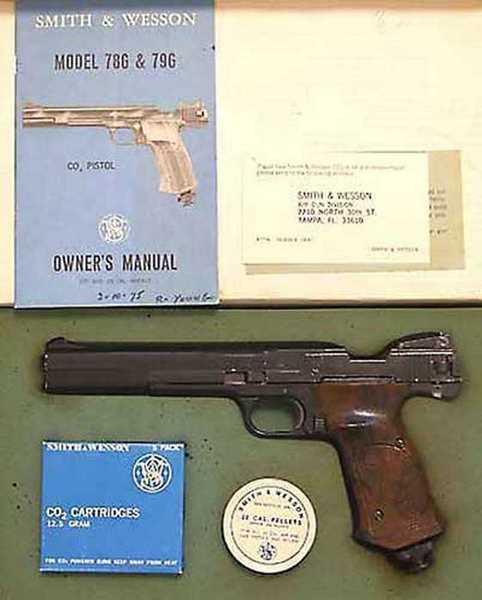
My S&W 78G pistol.
Today’s report is written by reader 45Bravo. This is his report to us on the Daisy air pistols that followed the S&W 78G and 79G.
If you’d like to write a guest post for this blog, please email me.
And now, over to you, 45Bravo.
The decline of the Smith & Wesson 78-79 series
This report covers:
- History
- What’s on the outside
- On the inside
- Daisy trigger
- Daisy model 41
- Daisy 7900?
- So, how do they shoot?
- S&W #2074 has Mac1 upgrades in valve poppet and valve spring, and o-rings
- S&W #3248 has factory poppet and valve spring, but new o-rings
- S&W 79G has factory poppet and valve spring, with new o-rings
- The Daisy 790 has Mac1 upgraded poppet and valve spring and o-rings
- Why would I throw over $100 in parts into a Daisy 790?
- Summary
- The Daisy Line?
The decline of the Smith & Wesson 78-79 series
These observations come from having 4 of the guns at my disposal at this time.
A 78g serial number 2074, with a manual dated 4/71.
A 78g, serial number 3248.
A 79g, serial number 294,6XX, with a manual dated revised 11/77
And a Daisy 790, serial number 3J00891 (third change).
When I get a Daisy Power Line Model 41 in I will do a article on that model.
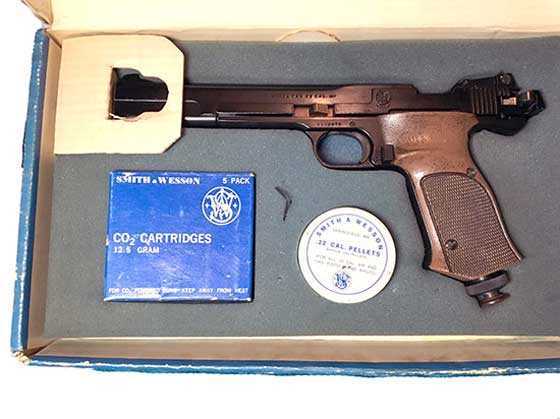
S&W 78G.
History
The S&W 78g and 79g (.22 and .177 calibers respectively) were made by Smith and Wesson for owners of their Model 41 .22 rimfire target pistol, to be able to practice target shooting indoors or in their yard. The first ones were made with an adjustable trigger, and 2-stage power selection, and adjustable power overall through changing the hammer spring preload.
Soon Smith and Wesson’s legal department became afraid of their adjustable trigger after drop tests were conducted. They removed the adjustable trigger feature, but kept the adjustable power feature.
These pistols were made from 1970 until 1978, at which time they sold the tooling to Daisy. Daisy continued production under the model numbers 780 and 790.
After the sale when a recall was issued or when Smith & Wesson guns needed service, they were to be sent to Daisy for the work to be done. When the modifications were completed, the frames were stamped with the letter D near the piercing cap. Any guns produced after the recall came with the modifications already done and did not need to be stamped.
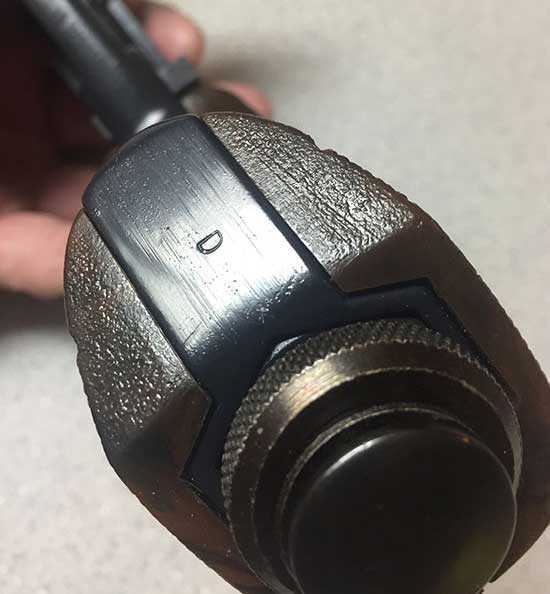
Every new modification to the pistol by Daisy reduced the cost of the pistol, and in the opinion of many people, also reduced the quality of the guns.
Now that we have covered a little of the history of the guns, let us look a little deeper.
The Smith & Wesson 78/79g air pistol, and the Daisy 780/790 air pistol: What’s the difference?
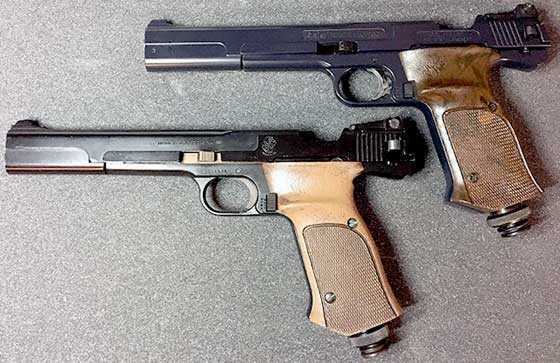
The early Smith & Wesson 78G is the bottom pistol with the lighter color grips. The Daisy 790 is at the top.
What’s on the outside
Pistols from the two manufacturers feel the same, and they look the same. The differences are in the details. The early Smith & Wesson guns had very light colored and cheap-looking plastic grips. As time passed they improved the look by making the plastic grips darker with more pronounced colors and simulated grain. Daisy kept the nice-looking grips in their production.
When Daisy first took over production, from what I understand, they used some of the leftover parts from Smith & Wesson where they could. They also changed things in other places. Daisy changed the rear sight to a plastic one. The bolt release was changed to a plastic part, but the bolt itself is still metal. And the entire assembly was simplified. Daisy did improve one thing, on the loading bolt they added a third position, that lets you store the gun with the bolt partially retracted from the barrel so the bolt seal o-ring is not compressed.
On the inside
Over their production run, Daisy simplified the power adjuster to a 2-piece design and made it out of plastic. They changed the barrel retention system and the power-adjustment system to a pin near the muzzle instead of the screw-in system of the Smith & Wesson.
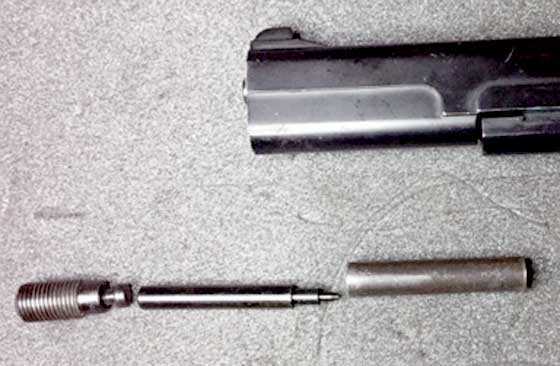
This photo shows the Smith&Wesson power adjuster out of the gun.
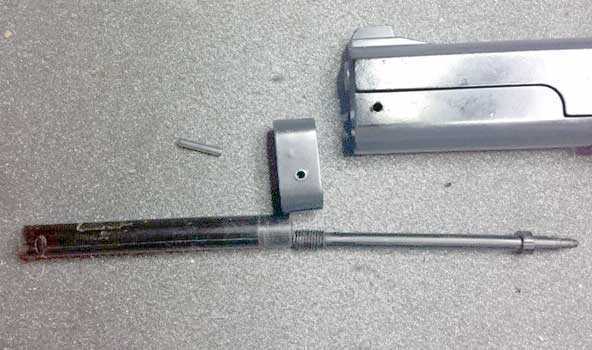
The Daisy 790 power adjuster out of the gun.
Daisy changed the transfer port from a metal one, to a plastic one. Daisy changed the trigger from the sintered metal trigger of the Smith & Wesson to a cast one, and modified it to where the safety can be engaged with the gun uncocked.
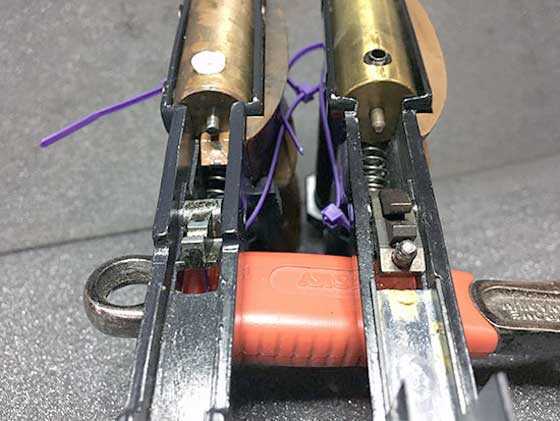
Here is the Smith & Wesson (right) and Daisy (left) lower receiver side-by-side. You can see the white plastic transfer port Daisy used. The zip ties are just holding the trigger and trigger springs in position for the photos.
Daisy changed to a 2-piece hammer. It offers greater safety, so when you fire the gun, the hammer strikes the valve stem, but when you release the trigger, it then moves the hammer upward and lets it rest on the valve face. It cannot fire the gun unless the trigger is held all the way to the rear.
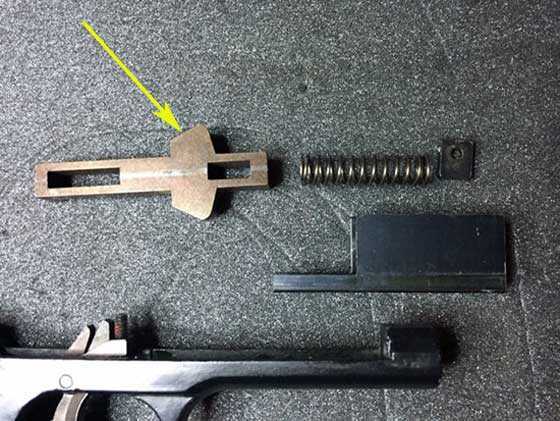
The hammer/striker in a 78G (arrow) is one solid piece.
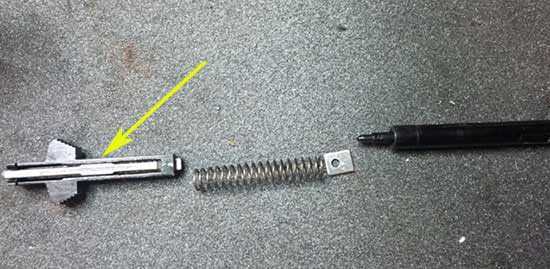
The 790 hammer is 2 pieces — an inner piece surrounded by an outer shell.
And here is how the Daisy hammer works. Just like the S&W pistols, the Daisy hammer is cocked by being pulled away from the valve stem and against the tension of the hammer spring.
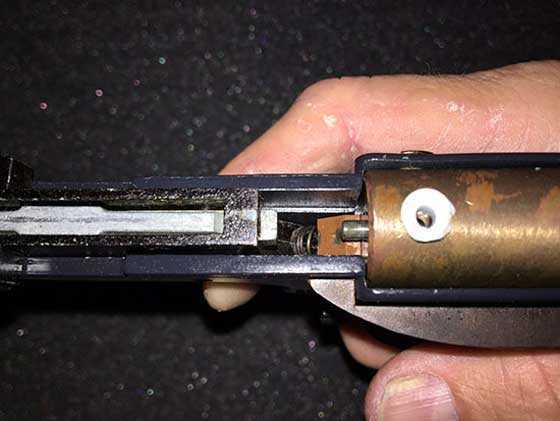
The Daisy 790 hammer shown here is cocked — ready to strike the valve stem when released by the sear.
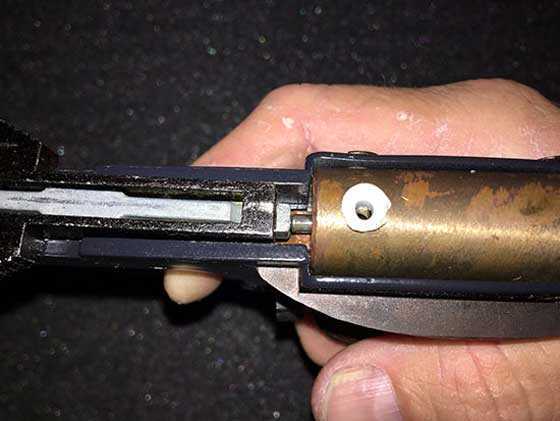
The 790 trigger/sear has released the hammer and it has impacted the valve stem, releasing gas.
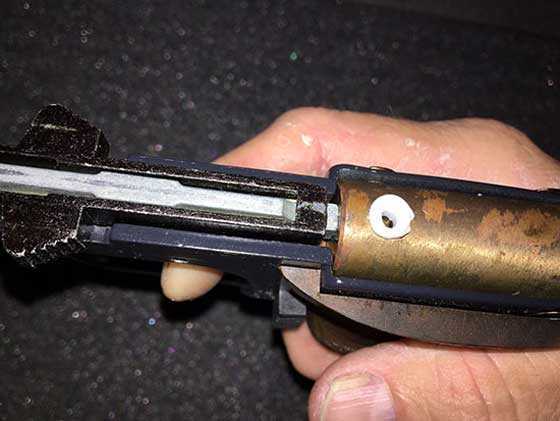
After firing the trigger has been released and the inner part of the 790- hammer has shifted up against the valve body. It cannot touch the valve stem now.
Daisy trigger
These changes made the Daisy trigger safer, but it’s also extremely long and heavy, making the pistol very hard to shoot well. Daisy also removed the hammer/spring guide channel from the front of the lower receiver. That can be seen in the photo above that shows the two lower fames next to each other..
Over the Daisy production run, I have found 4 changes before Daisy released the chrome-plated Model 41 air pistol. The pistol tested is what I consider to be a third change model.
When the Model 41 came out, they changed the CO2 cartridge arrangement. The pistol now positioned the cartridge with its tip up, and had a simplified CO2 cap, instead of the more expensive striker piercing cap of the earlier models.
The o-rings of the bolt probe, and the valve arrangements still interchange with the earlier guns, so resealing them can still be done.
Daisy model 41
This last model was a chrome-plated airgun that was more of an homage to the Smith and Wesson 41 firearm than a serious informal target air pistol. The Model 41 was the last gasp for the design, and was in production for a very short time, and you don’t see very many for sale online, and even finding images online of the Daisy model 41 is difficult.
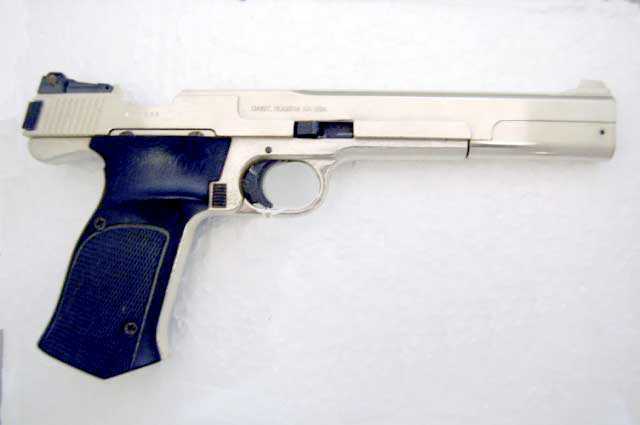
The rare Daisy model 41.
I see more 78g models than 79g models, and in my opinion, of the entire run of manufacturing from both companies, the rarest model seems to be the Daisy model 41.
Daisy 7900?
I see references online about a Daisy 7900 air pistol, but have yet to see an actual image of one, much less actually see one in person. After a conversation with the Daisy Museum, I learned that Daisy never produced a model 7900 air pistol. Apparently it is an example of the Mandela effect.
So, how do they shoot?
I chose to use Crosman Premier pellets for the test as most shooters will buy a tin of them before they buy or test more expensive pellets.
With the exception of the Daisy 790, all shooting was done with the power adjusters set in the middle of their adjustment ranges. The 790 was not adjusted as the plastic velocity adjustment is delicate and prone to breaking if adjusted with a screwdriver. Also, it is set where it shoots the best with its preferred pellet.
All strings 20 shots per string.
a new Crosman 12 gram co2 cartridge
14.3gr. Crosman Premier in .22
7.9gr. Crosman Premier in .177
Temp: 85 deg. F.
All guns and co2 cartridges were allowed to warm up to ambient temperature in the shade.
Timed 30 seconds between shots.
Recorded with a Caldwell Ballistic Precision Chronograph 1 ft from the muzzle.
S&W #2074 has Mac1 upgrades in valve poppet and valve spring, and o-rings
14.3gr. Crosman Premier.
High: 402
Low: 386
Average: 392.4
Spread: 16 fps.
Fpe: 4.9
Can it shoot faster? : Yes. But with only 16fps variation over the first 20 shots, its the best I have found yet for this pistol. I have not found “the” pellet for this pistol yet.
S&W #3248 has factory poppet and valve spring, but new o-rings
14.3gr. Crosman Premier.
High: 376
Low: 349
Average: 359.9
Spread: 27 fps.
Fpe: 4.0
I recently purchased this gun and it will get a complete rebuild.
S&W 79G has factory poppet and valve spring, with new o-rings
7.9 gr. Crosman Premier.
High: 442
Low: 401
Average: 421.5
Spread: 41
Fpe: 3.1
This gun is not mine. The owner just wanted a reseal, nothing else.
The Daisy 790 has Mac1 upgraded poppet and valve spring and o-rings
7.9 gr. Crosman Premier.
High: 519
Low: 511
Average: 514.2
Spread: 8 fps!
Fpe: 4.6
This particular Daisy is very accurate even with the heavy trigger. We all know Daisy can make an accurate barrel (the Daisy 953 is a prime example). Unfortunately they had to let their lawyers into their triggers.
{Editor’s note: Daisy is the highest-profile airgun company in the world. Many people who are not airgunners use the term Daisy to mean all airguns. As a result, they are the targets for many lawsuits. Their lawyers have to be vigilant, just to stay in business.}
Because of its accuracy when I first bought it a year ago, I decided to put a complete Mac1 kit in it, and original Smith & Wesson trigger parts in this pistol.
Why would I throw over $100 in parts into a Daisy 790?
1. I don’t personally own a S&W 79g at this time.
2. Its a very consistent shooter.
3. It is accurate so it deserves to be enjoyed.
4. It is now the only Daisy 790 I know of with an adjustable trigger .
We will cover accuracy in a future article.
Summary
Smith & Wesson started off with a great pistol, but because of legal pressure they had to delete some of the better features.
They sold the airgun division to Daisy, who chose to make more compromises, which the customers did not like, so eventually through lack of sales it was ultimately dropped from production.
The aftermarket poppets seem to shoot more consistently than the factory ones.
If you can get Smith & Wesson 78 or 79 with the adjustable trigger, you will love it. Not having an adjustable trigger is not a deal breaker, as the non-adjustable trigger is still shootable. And the pistol was made in the USA, by Smith & Wesson, not in China under their license.
The Daisy line?
They were made in the USA, they can be accurate, they can be resealed, but trigger wise, you get what you get, as aftermarket trigger upgrades are nonexistent — unless you find someone on eBay parting out an adjustable trigger Smith & Wesson.
45 Bravo.

FWIW, gun number 3J00891 decodes as September, 1983.
Thanks for that information, can you give me some insight as to you you decode their serial?
There’s a thread HERE that has some info you may find helpful.
I’d like to own one of these guns someday. When I see them at auction sites they tend to go for hefty prices, especially the S&W version. But they are well worth it in my opinion.
45Bravo,
Thank you for the fine and detailed report. Well done and informative.
Good Day to you and to all,…….. Chris
Bravo 45Bravo! I enjoyed the history of these air pistols very much! Because of you and BB, I have decided to make a room available for one of these gals at RidgeRunner’s Home For Wayward Airguns should one desire to move in.
Cool, now the question.
.177 or .22?
Or like most of us, BOTH!
Ian,
I myself would prefer .177, but if one should show up in .22 I would not turn her away. 😉
I figured as much.
They are too much fun.
What is a 79G worth? I have one that I attempted to reseal with the O-ring kit several years ago but I believe the exhaust valve seal was the problem and I could not locate that part at the time. I see they now sell a kit with that valve but I’m not sure I really want to bother with this gun and I’ve been contemplating what to do with it.
A 79G that’s not working is worth what you can get for it. If a working one sells for $125 a non-working one that’s in nice shape should bring $50 or even a little nore.
B.B.
45 Bravo
Always enjoy getting into the workings of an airgun. Thanks for all the pictures.
Another model I never knew existed.
45Bravo,
I ask your forgiveness for going off subject so early, but I could not stand it.
While perusing for top shelf airguns at a very well known airgun dealer site, I stumbled upon the LCS Air Arms SK-19 Automatic Air Rifle. It looks similar to the FX Impact, but is most definitely based on the Huben K1. It is also selective fire. It is supposedly going to be available this month.
Here is there site.
http://lcsairarms.com/
RR
Please stop posting links for auto and semi-auto pellet guns. You don’t know what that does to the old heart and blood pressure.
Great now another I got to figure out how to get. You know I got a soft spot for semi-auto/full auto pcp’s.
GF1,
MMUUHHAHAHAHAHAHAHA! Now who is being the Enabler?
If the truth were known I would much rather have a FX Dreamlite Compact in .22, however it would be pretty awesome to shred a pack of feral soda cans at 200 yards.
This is a stripped down to the bare bones, form follows function Huben K1 with selective fire. If I was to own a semi / selective fire air rifle, this would be it. I was thinking of doing just this to a Huben K1.
RR,
That would be awesome at a ground hog at 30 yards or so. Overkill?, sure,…. but as hard and elusive as they can be to get,…. that would be some fun payback therapy.
I like all of the advancements in airguning.
Chris
Chris
How many shots do you think you would hit with it?
GF1,
All!,…. I would hope! 🙂 In reality, there would be some extra bouncing about. If you note, that one rest locked things down. On HAM, they showed the same one I think very recently at an event and it too looked locked down (clamp rest).
It would be fun.
Chris
Chris
Heck you could take out a whole pack of feral cans with one pull of the trigger.
Yep for sure fun.
Chris,
I could not do that to an animal. That is one of the reasons I am such a stickler for accuracy. One clean shot. End it as fast as possible.
RR
Trust me I like it. If I had some spare change there’s a couple full auto select fire pcp’s I would like to get.
GF1,
I do understand.
45Bravo
Thanks for the info today.
Thanks 45Bravo for the detailed and well illustrated report. This brings back old memories. I purchased one of these pistols in 0.177 around 1982. I do not recall the model, but I do remember that it had the dark grips. I did enjoy shooting it, the sights were excellent and it was quite precise in spite of the mediocre trigger.
Unfortunately, it also was a bad leaker right out of the box. I tried everything I knew including replacing a couple of o-rings but nothing worked. I ran out of ideas, got frustrated and gave it away. Now I wish I had kept it, but it is what it is.
Rgds.
Henry
45Bravo,
Thank you for the very nicely detailed report, and special thanks for including so much in the history section; I think it’s important for someone like you, who has a nice selection of these pistols, to document your findings here in B.B.’s blog, since this information will be looked at for years by a variety of airgunners (as all of his stuff is =>).
Kudos to you,
dave
45Bravo,
Wow. I am impressed by the detailed knowledge and superb writing of your report. It is quite an achievement. I think you have just provided airgunners with a landmark source of information on the classic S&W air pistols. I have bookmarked it so I can refer to it again and again if ever I need to. Again, wow. This is a valuable contribution to the canon of air gun reference materials.
Congratulations on this report, and thank you for writing it.
Michael
Everyone,
Just so you know — this won’t end here. 45Bravo has said he will show us how to reseal the S&W pistols, too!
B.B.
45Bravo,
Thanks for the look inside, and the history lesson. You know; now there is a whole bunch of us readers added to the competition in purchasing these pistols. I can’t wait for your next report.
Thanks
Don
45Bravo,
Very nice job on this guest blog, very informative as well, with excellent photos. Thank you.
Geo
I enjoyed your blog.
I have owned 4 of the S&W 78/79 series. Two adjustable trigger S&W 78s, a non adjustable trigger S&W 78, and a non adjustable trigger S&W 79. I have never seen a S&W 79 with an adjustable trigger. The S&W 78 without the adjustable trigger was the most accurate of the ones I have. The trigger was not adjustable, and not light, but it was very predictable.
One thing you didn’t mention is the different finishes. I think it was the oldest ones that had the polished “blued” look and the later ones had a more parkerized look. I think this happened about the time the non adjustable trigger came into use.
I would love to see a blog of a tear down and rebuild of the 78 if you are up to it.
David Enoch
David,
If you check I mentioned the finishes in Part 1.
B.B.
BB,
I started working on the review of the Diana Group Bullseye ZR Mount today. I will be the first one to admit that I am not the greatest shot in the world, but…
I would not give this mount to anyone. I wish I could get a refund.
RR,
Ahhh yes,…. the infamous “but”……..
Looking forwards to your review. That could explain why they are not all over the place by now.
I did I quick search (here) and came across this:
/blog/2015/03/back-to-the-basics-scope-tips-part-2/
275 comments on that particular blog. That has to be close to some sort of posts record. 2015? Has it been that long? So,…. it is pretty “safe” to say that it takes you “awhile” to get around to something? 😉
That must be where the “Roundtoits” come into play? 🙂
Chris
Chris,
This round tuit and many others of mine usually have a lot of research behind them. Then you add in the many distractions of life that are thrown in…
RR,
Thanks for taking the heat.
B.B.
RidgeRunner—Many years ago, I shot a Winchester model 70 target rifle ( in 30-06 ) with my Unertl 2′ target scope mounted on it. I did not use the return to battery spring because I was sure that the spring would snap the scope back with enough force to damage the scope.I let the scope slide forward in the mount, and pulled it back into battery after each shot , by hand. Of course, I used the spring when I had the scope on my .22 target rifles. I am sure that the Marines did not have the return spring on their Unertl target scopes when they put them on their 1903 sniper rifles. Is the ZR mount giving you a ping-pong movement that is damaging your scope ? ——Ed
RR— I just read the info that Chris mentioned in his comment. Have you tried removing the spring in the ZR mount, and pulling the scope back after the shot? I wonder if that would solve your problem?—–Ed
Ed,
Interesting. I would think that the ZR mount would return to position each time. That would speak more to eye relief,… which I think could vary considerably with the average shooter. What I would be concerned with more is angular return/repeatability. Up, down, left, right variances could wreak havoc on repeatability. Even a degree or two,…. maybe much less.
Chris
Chris—If the ZR mount had 2 springs, one at each end, the scope would not move ( in theory) The rifle would move in both directions, but not the scope. Target scopes, like the Unertl, Lyman, Fecker, etc. used a spring to force the scope tube against the windage and elevation screws. This system ensured repeatability. I do not know if a sliding mount like the ZR can have tight enough tolerences to ensure the same degree of repeatability as the target scopes.——-Ed
Ed,
It was my understanding that the scope moving was the whole purpose of the ZR mount (minimize impact to the scope internals). Like putting a firearm scope that is not air gun rated on a springer.
In reality, there is now a wide selection of quality scopes that will do both. So the ZR mount addressed a problem that is now largely extinct.
Either way,…. I enjoy seeing the innovation and new ideas.
Good Day,……….. Chris
Chris—When a scope is locked into a mount, it recoils with the rifle. When the scope is in a mount that allows it to move, it stays in place while the rifle recoils. In a firearm , with a scope in a target mount, the rifle moves backwards, the scope stays in place. The scope will have to be pulled back into battery, after the shot is fired. This creates the illusion that the scope moved forwards. That is why we have seat belts in cars. Without them, if the car stops quickly, the passengers keep moving forward ( until they hit the dash). In fast elevators, the same things happen ( in a vertical direction) when the elevator stops, or starts quickly. When a scope is in a fixed mount, the same force acts on the internal parts, and tries to take them apart. This force is called inertia. Of course, in a springer air rifle or gun, there is both a forward and a backwards movement . So inertia will act in 2 directions. Have you ever been in a n elevator that quickly jerked up and down ? Or a train that did the same ?——ED
Ed,
Thank you for the additional insight. I am not familiar with “target mounts” No on the elevator or train,… but I have been in a car without wearing a seat belt (years ago),…. and yes,… you will keep moving forwards until you strike something and/or go through something.
Chris
Chris—- Re the train, I meant forwards and backwards, not up and down. ——Ed
Chris—- Just google unertl scopes—and you will be rewarded with pictures and a plethora of information. —–Ed
Ed,
Note made and I did do a quick search before work today AM. 10 min., maybe. I will investigate further this weekend.
Thank you,……… Chris
This article shows very good understanding of BOTH subject AND audience. Many times authors nail the first and miss the second by “preaching to the choir.” BB is gifted with a talent of both. Seems like he’s picky about who gets to write the guest blogs, because the blogs by Vanna and yourself have been excellent as well!